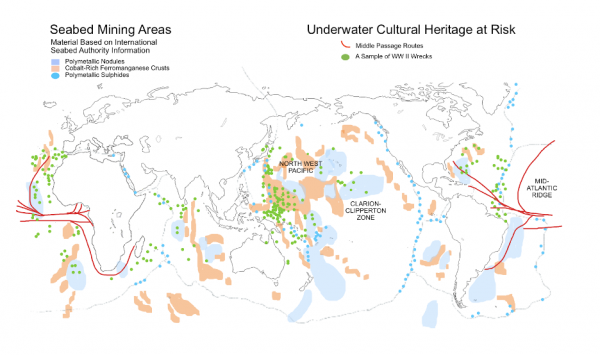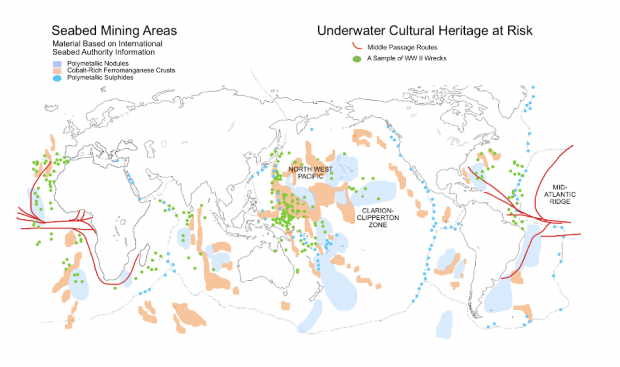By Charlotte Jarvis and Ole Varmer
Bottom Trawling
Ecologists and fishery scientists have been concerned about bottom trawling for centuries. The first known reference to the activity is in a 1375 English Parliamentary document and that initial mention highlights the destructive nature of the practice (Petition by the Commons to King Edward III, 1376 seen in Bolster 2012, p. 235). Bottom trawling impacts the natural heritage of the ocean in many ways, including by reducing topography, compression, and resuspension of sediments, decreasing complexity, causing both physical and chemical damage to the ecosystem, and the collapse of fish stocks. But it is not just the natural heritage that is impacted by this activity.
Although legislation that limits trawling can help biological communities rebound, the archaeological material lost can never be recovered (Brennan et al. 2015). Maritime archaeologists and marine ecologists need to communicate and work together with fishers and policy makers to find ways to limit harm. Damage to shipwrecks can include mixed sediments, changing chemical degradation processes, artefact damage and movement, and destruction of a site’s context. Additionally, nets and other fishing gear can snag on a wreck, warping the metal features or cutting through wooden elements. The site’s integrity can be completely destroyed.
Deep Seabed Mining
There are also future challenges facing UCH. Deep seabed mining operations (DSM) that interact with tangible UCH and intangible. Deep seabed mining (DSM) is a potential commercial industry attempting to mine mineral deposits from the seafloor, in the hopes of extracting commercially valuable minerals such as manganese, copper, cobalt, zinc, and rare earth metals. However, this mining is posed to destroy a thriving and interconnected ecosystem that hosts a staggering array of biodiversity: the deep ocean.
Commercial DSM has not started, but various companies are trying to make it a reality. Current proposed methods of nodule mining include the deployment of a mining vehicle, typically a very large machine resembling a three-story tall tractor, to the seafloor. Once on the seabed, the vehicle will vacuum the top four inches of the seabed, sending the sediment, rocks, crushed animals, and nodules up to a vessel waiting on the surface. On the ship, the minerals are sorted and the remaining wastewater slurry (a mix of sediment, water, and processing agents) is returned to the ocean via a discharge plume.
Current International Seabed Authority (ISA) exploration and exploitation draft regulations are not sufficiently protective of UCH. For example, the regulations do not require the real time monitoring of operations and transmission of relevant data, which would enable identification of tangible UCH and the halting of destructive activities to protect that heritage.
DSM will also affect intangible cultural heritage. In one specific example, noise from DSM has the potential to negatively impact local practices, such as shark calling, as well as the migration of whales– which have cultural importance to many people globally (Tilot et al. 2021). Concerns have also been raised about DSM’s interactions with some cultures’ understanding of responsibility to the ocean or special regard for the deep ocean. Such conversations have not found a place in regulatory development at the ISA but a new intersessional is meeting to work on this.

Figure 1. Threats to UCH from seabed mining. A sample of the UCH at risk from the ISA’s proposed seabed mining activities (Source: Image created by Charlotte Jarvis based on ISA Information, SPREP Pacific Wreck Database and Turner et al. 2020).
Potentially Polluting Wrecks
Additional threats to heritage, both natural and cultural, can come from the material itself. While the wrecks from the World Wars are part of our cultural heritage, they are also posing a significant pollution threat to the marine environment, fishing, and other livelihoods that are dependent upon a healthy ocean. A potentially polluting wreck (PPW) is a shipwreck containing a cargo or a large volume of its own fuel that remains within the wreck and has the potential to cause an environmental hazard should the structure become compromised and either leak or catastrophically release (see Brennan et al. 2023 for more information).
The wrecks identified as PPWs are most thought to be those sunk during World War II, particularly oil tankers, but also include freighters, and include ships from parts of the twentieth century that foundered in storms. Only in the aftermath of the Deepwater Horizon spill and the research conducted in the Gulf of Mexico since, do we have a better understanding of some of the environmental impacts of such disasters to the deep-sea ecosystem. While some oil leak origins are known, many come from mystery sources and will pose future damage (NOAA 2012).
A New Project and Steps Forward
TOF has a new project that aims to bring awareness to these threats to UCH from bottom trawling, potentially polluting wrecks, and deep seabed mining. The project is in partnership with the Lloyd’s Register Foundation Heritage and Education Centre and has cooperation from The International Committee on Underwater Cultural Heritage (ICUCH) within the International Committee on Monuments and Sites (ICOMOS. It is an endorsed Activity under the UN Decade for Ocean Science. While the UN Decade for Ocean Science (2021-2030) has hundreds of endorsed ocean science activities, projects, and programmes that relate to natural heritage and ocean biosciences, there are very few endorsements that focus on cultural heritage. The Cultural Heritage Framework Programme, led by the Ocean Decade Heritage Network was the first and is to date, one of the only ones still. We are also very fortunate to have some of the Framework Programme team as well as the Heritage Network team writing contributions for the books and helping develop the themes.
Cultural heritage and natural heritage are intertwined when it comes to the ocean. UCH can support ecological marine biodiversity and helps boost sea connectivity. For example, with fishing, Pearson, and Thompson (2023, 3) argue that it is beneficial for sites with high UCH and high natural heritage to co-occur and be used strategically together. Shipwrecks often function as artificial reefs providing habitats, shelter, and adding hard materials to an otherwise soft seafloor (Brennan 2016, 172; Krumholz and Brennan 2015). Through this process of ‘spill over,’ protected shipwrecks can help increase the strength of surrounding fish stocks. Shipwrecks can be as indispensable to the seafloor ecology as a natural coral reef or seamount. Thus, shipwrecks should not be viewed solely in a cultural significance context; they are part of the natural ocean landscape as well as our cultural history.
Sources
Bolster, W. Jeffrey. 2012. The Mortal Sea: Fishing the Atlantic in the Age of Sail. Cambridge, Mass. London: Belknap Press of Harvard Univ. Press.
Brennan, Michael L., Dan Davis, Robert D. Ballard, Arthur C. Trembanis, J. Ian Vaughn, Jason S. Krumholz, James P. Delgado et al. 2015. “Quantification of Bottom Trawl Fishing Damage to Ancient Shipwreck Sites.” Marine Geology 371, no. 2: 82–8. https://doi.org/10.1016/j.margeo.2015.11.001.
Brennan, Michael L. 2016. “Quantifying Impacts of Trawling to Shipwrecks.” InSite Formation Processes of Submerged Shipwrecks, edited by Matthew E. Keith, 157–79. Gainesville: University Press of Florida.
Krumholz, Jason S., and Michael L. Brennan. 2015. “Fishing for Common Ground: Investigations of the Impact of Trawling on Ancient Shipwreck Sites Uncovers a Potential for Management Synergy.” Marine Policy 61, 127–33.
National Atmospheric and Oceanic Administration. 2012. 2012 Risk Assessment for Potentially Polluting Wrecks in US Waters. https://sanctuaries.noaa.gov/protect/ppw/pdfs/2013_potentiallypollutingwrecks.pdf.
Pearson, Natali, and Benjamin S. Thompson. 2023. “Saving Two Fish with One Wreck: Maximizing Synergies in Marine Biodiversity Conservation and Underwater Cultural Heritage Protection.” Marine Policy 152, 105613.
Tilot, Virginie, Klaas Willaert, Bleuenn Guilloux, Wenting Chen, Clement Y. Mulalap, François Gaulme, Tamatoa Bambridge et al. 2021. “Traditional Dimensions of Seabed Resource Management in the Context of Deep Sea Mining in the Pacific: Learning From the Socio-Ecological Interconnectivity Between Island Communities and the Ocean Realm.” Frontiers in Marine Science 8 (April): 637938. https://doi.org/10.3389/fmars.2021.637938.
Turner, Phillip, Sophie Cannon, Sarah DeLand, James Delgado, David Eltis, Patrick Halpin, Michael Kanu, et al. 2020. “Memorializing the Middle Passage on the Atlantic Seabed in Areas Beyond National Jurisdiction.” Marine Policy 122. https://doi.org/10.1016/j.marpol.2020.104254.

